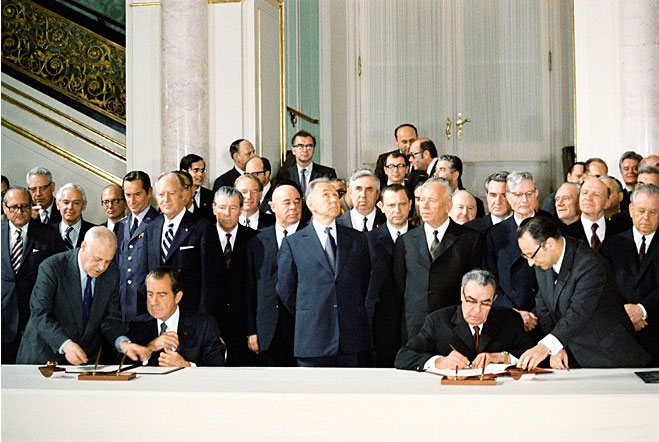1972 Moscow Summit

Signing Agreement
At the end of May 1972 President Nixon after a successful summit in China traveled to Moscow to meet Soviet Leader Brezhnev and they were able to finalize the agreement. The two leaders signed both an Anti Ballistic Missile Treaty that limited both sides to the number of sites to two sites protected by ABM’s as well as limiting the number of ballistic missiles both sides had to the numbers they currently had in place. .
The 1972 Moscow Summit, also known as the Nixon-Brezhnev Summit, was a historic meeting between the United States and the Soviet Union held from May 22 to May 30, 1972. The summit marked a significant milestone in the détente era of the Cold War and aimed to improve relations between the two superpowers. The primary participants were U.S. President Richard Nixon and Soviet General Secretary Leonid Brezhnev, who engaged in a series of discussions on arms control, trade, and other critical issues.
The Moscow Summit's primary goal was to negotiate the Strategic Arms Limitation Talks (SALT) agreements, which sought to curb the arms race between the United States and the Soviet Union. The SALT negotiations were initiated in 1969 and had reached a critical stage by 1972. The Moscow Summit provided an opportunity for both nations to finalize their agreements and commit to reducing the risk of nuclear conflict.
On May 26, 1972, Nixon and Brezhnev signed the Anti-Ballistic Missile (ABM) Treaty and the Interim Agreement on Offensive Arms, collectively known as the SALT I agreements. The ABM Treaty limited the deployment of defensive systems designed to intercept incoming nuclear missiles, thereby reducing the incentive for either side to develop a first-strike capability. The treaty allowed each country to maintain two ABM sites, with one protecting the capital and the other safeguarding an intercontinental ballistic missile (ICBM) launch area. The Interim Agreement on Offensive Arms, also known as the "freeze agreement," placed a temporary cap on the number of ICBMs and submarine-launched ballistic missiles (SLBMs) each side could deploy. The SALT I agreements marked the first-ever bilateral effort to limit nuclear arms, emphasizing mutual restraint and reducing the risk of nuclear war.
Apart from the SALT I agreements, the Moscow Summit facilitated negotiations on several other key issues. Nixon and Brezhnev signed a joint statement on the "Basic Principles of Mutual Relations," which outlined principles for peaceful coexistence and cooperation between the two nations. These principles included respect for each other's sovereignty, territorial integrity, and political independence, as well as the commitment to peaceful resolution of disputes and non-intervention in internal affairs. This statement set the tone for the development of the U.S.-Soviet relationship during the détente period.
Trade between the U.S. and the Soviet Union was another significant topic discussed during the summit. Both sides sought to expand economic cooperation and recognized the mutual benefits of increased trade. They signed an agreement on scientific and technical cooperation, promoting collaboration in various fields, including space exploration, health, and environmental protection. The two nations also agreed on a long-term grain deal, which facilitated the Soviet Union's purchase of American grain to address domestic shortages.
Cultural exchange was another area of focus during the summit, with both nations acknowledging the importance of fostering mutual understanding and respect. Nixon and Brezhnev signed an agreement on cultural, educational, and sports exchanges, promoting opportunities for people from both countries to learn about each other's history, culture, and way of life.
 >
>